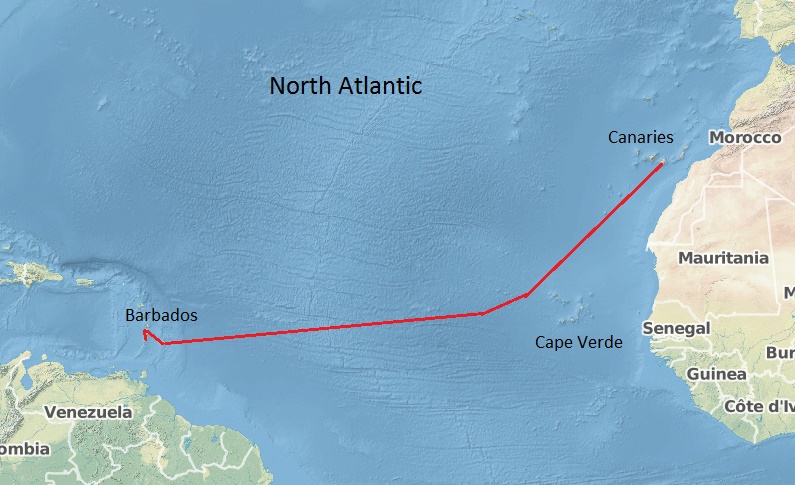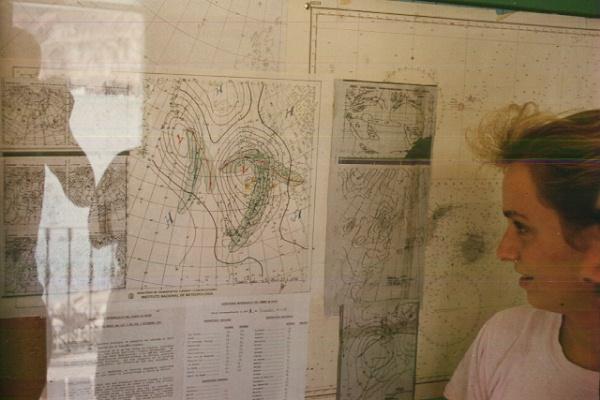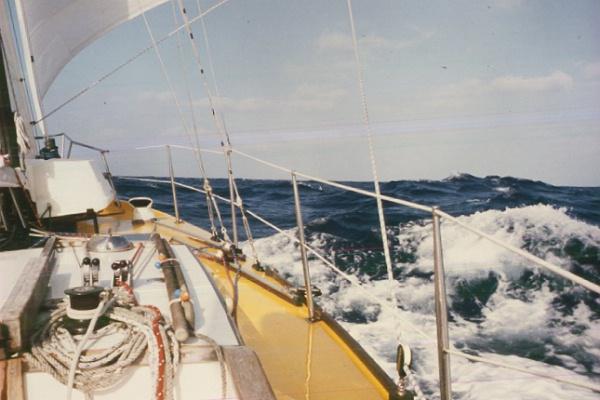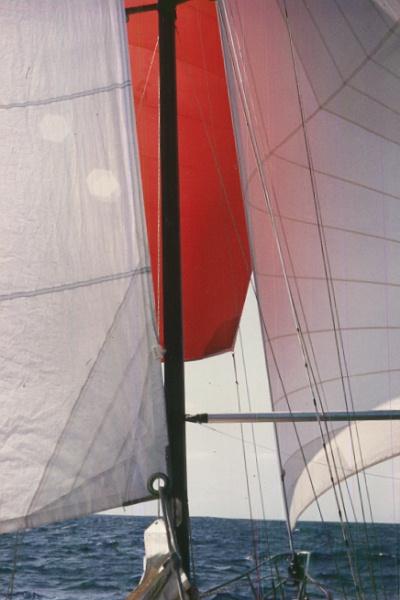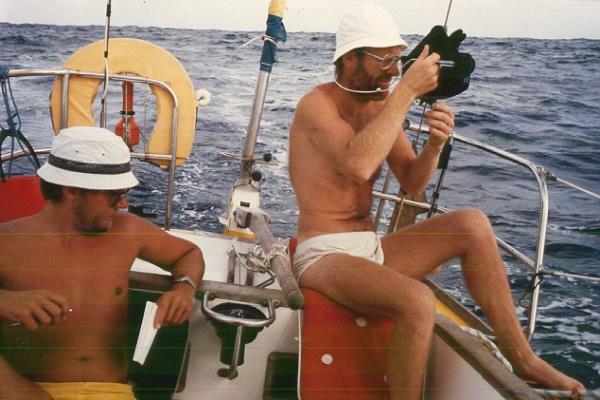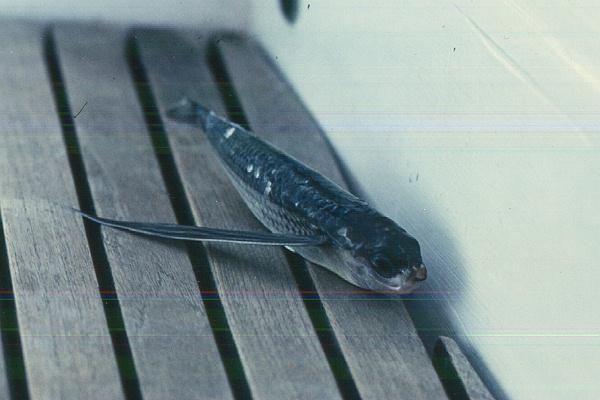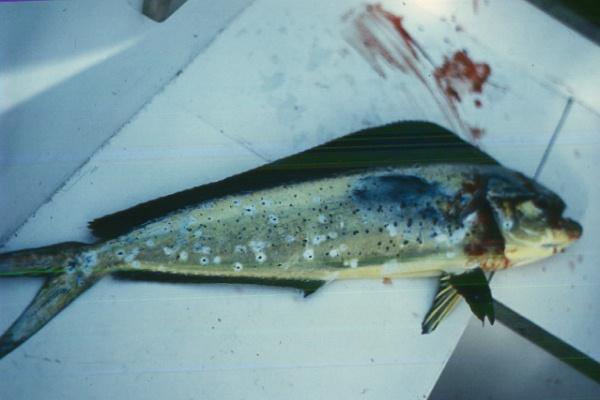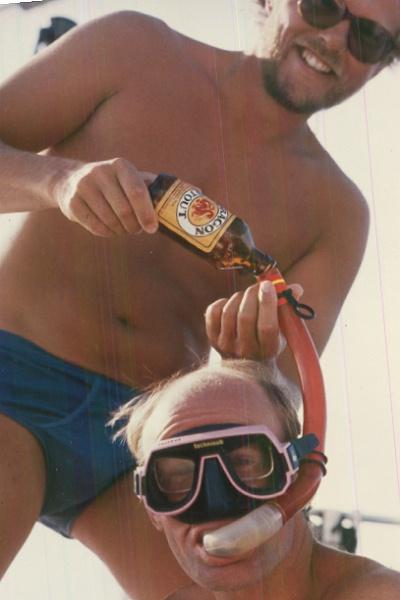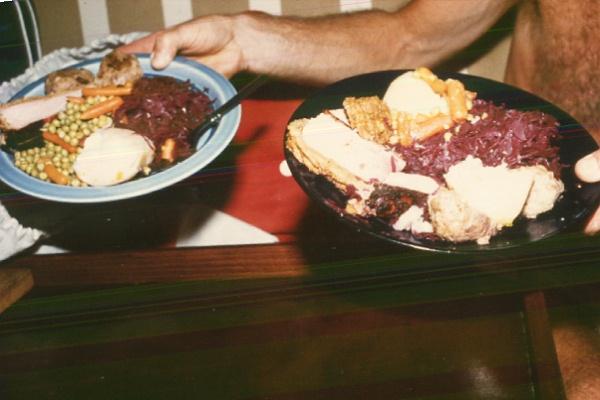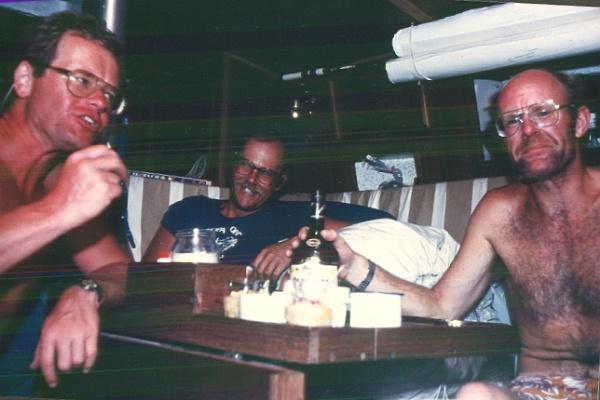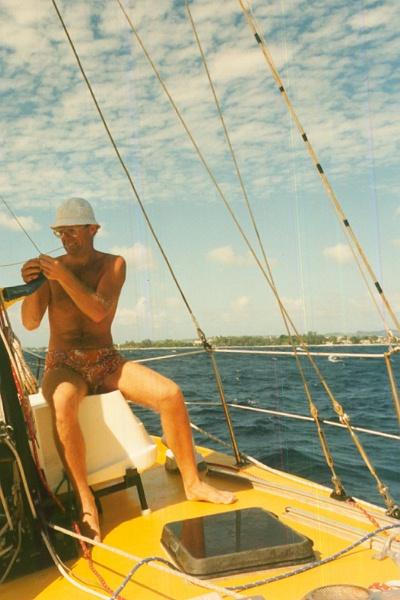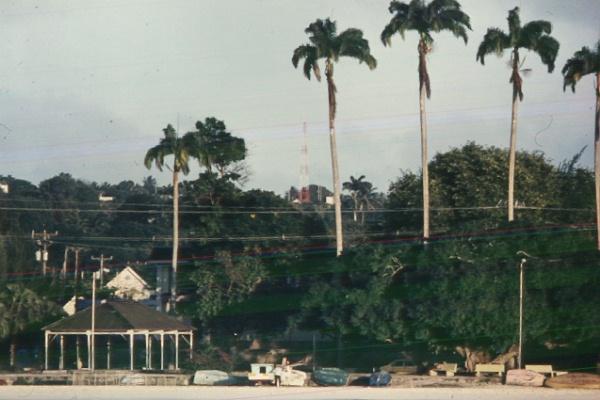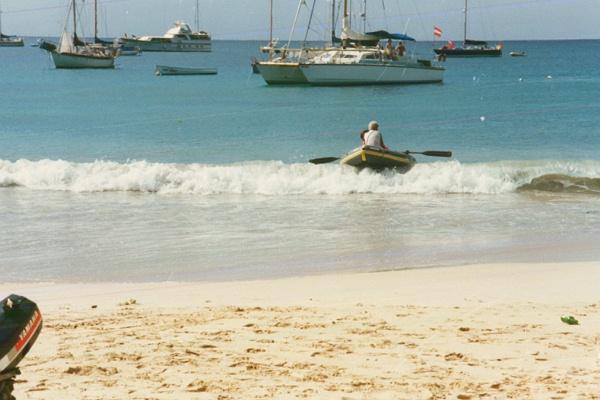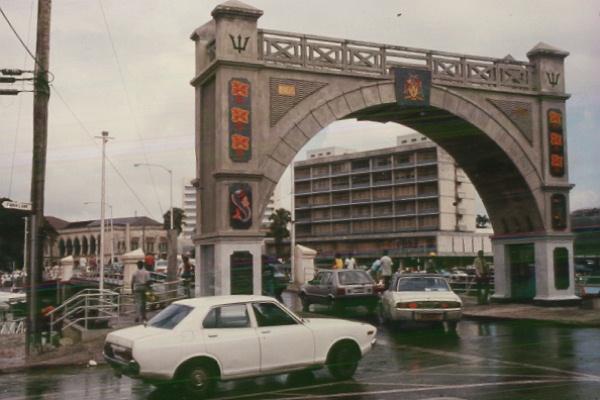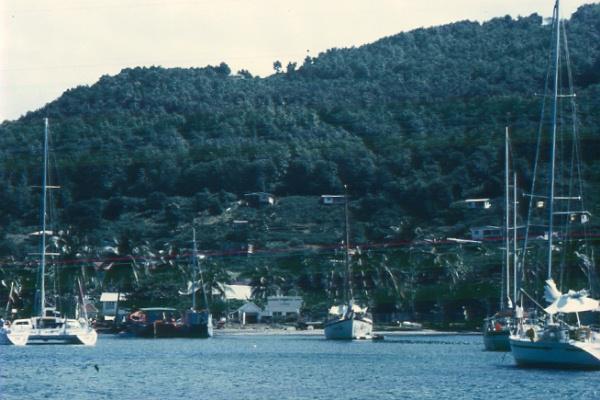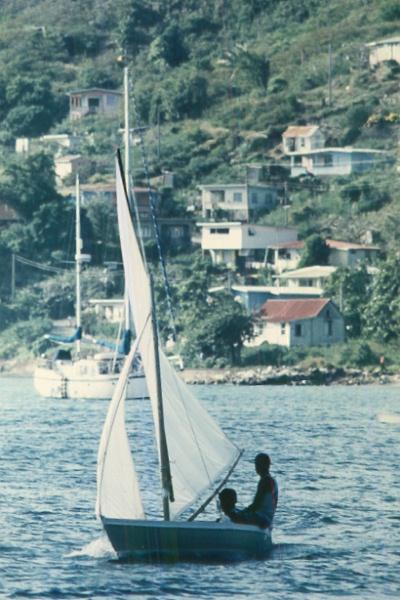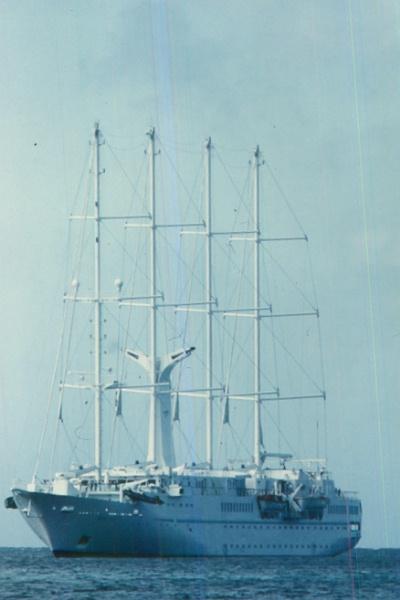
 Winter 1987-88
Winter 1987-88


To the Caribbean with Dilly Dally
Across the Atlantic by Johan Kjellander 1987-2019 På svenska
My very good friend David spent many years building a 9-meter sailboat in his garden. He named her Dilly Dally and when she was completed David sailed her from Sweden to the Canary Islands. In November 1987 I and Tord joined David on the Canaries to crew on Dilly Dally across the Atlantic. We had 23 days of sailing from Puerto Mogan on Gran Canaria to Bridgetown on Barbados. Fantastic days that inspired me very much. Tord took these pictures and I wrote the texts.
From the Canaries to Barbados
We stayed in Puerto Mogan in southern Gran Canaria for provisioning a week at the end of November before we left. Food and water in large quantities every single day and a lot of work on stowing everything. Every day we went up to the marina office to check out the latest weather forecast. It was important to keep an eye on the so-called Azores high pressure that drives the north-west trade winds towards the Caribbean. The best thing is if the Northwest starts at the Canary Islands, then it is just to hoist and hang on. If you have bad luck you may have to sail a bit south before you find the right wind.
There is always a special atmosphere in a harbor where many sailors are preparing to cross an ocean. Everyone talks to each other and discusses equipment, provisions and routes. Some boats are waiting for crew and some crew have no boat so they ask around if there is space available. After a week, you have come to know several crews.
Finally however, we were on our way. We had hard weather to begin with and were all more or less seasick, but after a few days the weather stabilized and our seasickness disappeared. Dilly Dally is a relatively heavy boat but cozy and very seaworthy. In spite of the bad weather, she sailed herself, first with a windvane and then with an electric autopilot all the way to Barbados.
After a while, we found the trade wind and in the beginning it was quite weak. We tried different ways to raise as much sail as possible. Here it is spinnacker + genoa + a loose-footed storm jib on the aft stay! It is important to find a combination that gives good speed without too much supervision. Each of us took one 4-hour pass during the dark hours, 20.00-24.00, 24.00-04.00 and 04.00-08.00. The rest of the day we improvised and helped each other with most things. Breakfast at 8 and dinner at 5 o'clock.
We were three on board and had an autopilot so it was quite decent. A Norwegian boat that we got to know in the Canary Islands with only two people on board had problems with their autopilot after just a few days and were forced to hand steer almost all the way. That's tough. Someone has to be at the helm all the time, staring at the compass. We met them in Barbados and then they were completely exhausted.
We navigated with a sextant. The skipper was well educated and we helped him to register the exact time for each observation. Twice a day, five sun heights were taken at one minute intervals. Then the skipper went down and made his calculations and after a while he told us how far we had sailed since the last sunrise. If it went well it could be up to 130 nautical miles a day and if it went bad we were down to 30. We had very little fuel and had to sail as much as possible. Diesel made it possible to charge the batteries and secure the supply of power to the autopilot.
After about 20 days we sighted a ship and called them on the VHF radio to get a true position. They gave us a position from their satellite navigator and it differed only 5 nautical miles from our own position according to the sextant and David's calculations. Since then, I've always had a hard time getting impressed with satellite navigation.
We saw a lot of flyfish on our way. They often came in large numbers and flew beside the boat and then dived back into the water again. A few times they missed and ended up on the boat instead. In general, they then managed to get back into the water themselves but some got trapped on board. One even ended up on the floor in the galley. If someone had happened to be there with a frying pan ready, he would have been able to get it directly into the pan!
The fish to the right is a Gold Mackerel. We had a fishing line hanging after the boat and could have eaten Gold Mackerel almost every day if we wanted. Sometimes we fried them as fillets or we made a fish soup. Very delicate and beautiful fish. The skin shimmered like pearls and could change color from light yellow to green or purple blue.
The weather was mostly warm and sunny. It was important to drink a lot to replace the fluid loss. In order not to spill any of the precious liquid, we invented this device!
As Christmas approached we tryed to establish a little atmosphere with Swedish Christmas food. What do you do if you are in a small boat in the middle of the Atlantic without a refrigerator, oven or other features. Well you take a Danish canned ham, an egg, some breadcrumbs, mustard and grill the ham in a saucepan on the boiler. Then you take a can of meatballs in sauce, wash off the sauce and fry the meatballs in the frying pan. On top of that, some vegetables from different cans and finally a snaps of course...
We probably had both one and two snaps. Christmas Eve you have to celebrate somehow.
After 23 days and 2600 nautical miles, we heard the radio beacon on Barbados for the first time. Then we saw land and then it was time to set up the courtesy flag. It felt strange to know that the sailing was soon over and that the routine we had worked out on board would now be broken. Almost a little worrying actually.
The course was set for Bridgetown, located on the west side of Barbados, protected for the trade wind. Here is the well-known Carlisle Bay where many Atlantic sailors meet after their crossing. We arrived a few days before New Year and stayed here over the festivities.
While Carlisle Bay is well protected from the trade winds, the waves from the Atlantic are still rolling around and can occasionally provide a strong swell that creates a troublesome surf near the beach. Coming ashore dry with the dinghy was not always possible! The water was warm and clear. About 25-30 degrees all year round.
Here is the bridge that gave the city its name. Bridgetown is the capitol of the small country of Barbados. The population consists of Creoles (mixture of Africans and Indians) and white.
When New Year's celebration was over, we continued approximately 100 nautical miles further west to the small island of Bequia. Here, there is also a protected bay on the island's western side. We snorkeled, dived on wrecks and coral reefs and spent time with other sailors. We had met several of them already in the Canary Islands a month earlier.
On Bequia the people build their own sailboats. Young guys sailed in the bay and sometimes they came out to the visiting boats to sell fruit or other goods.
There are plenty of large cruise ships in the Caribbean. This modern sailing ship came to Bequia when we were there. It anchored up and then the tourists were taken ashore in small motorboats. For a day, the small community was invaded by American tourists who bought CocaCola, beer, ice cream and souvenirs. In the evening they returned to the ship again and the next day they were gone. Tourism must be one of the most important sources of income for the people here.
6 weeks after Tord and I left Arlanda it was time to fly home again. We sailed from Bequia to St. Vincent, just next door and flew from there in a small aircraft to Barbados and then with regular flights to Arlanda again via Florida and New York. It felt quite strange to get out of the plane in Sweden with freezing temperatures and snow on the ground. After an adventure of this kind it takes a while before you are home again mentally.
David remained in the Caribbean. He works as a skipper on various boats but sails a delivery every summer home to Europe to come and visit. By now, he has at least 10 Atlantic crossings behind him. Dilly Dally does not sail very much now but is on land in St. Lucia and serves as a residence for David when he is there.
PS: David decided to get rid of Dilly Dally and move home for good after more than 15 years in the Caribbean. He died unexpectedly from a heart failure in his home in late 2004, 59 years old. His friends spread his ashes in Lake Hjälmaren. In 2016 when Tove and I sailed with Bird of Passage in the Caribbean we searched for Dilly Dally in various marinas on Saint Vincent but did not find her. We still miss David very much.
